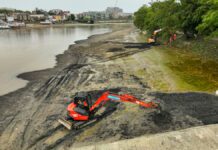Kirk Meikle, from spills countermeasures expert Darcy Group, offers a few thoughts on how new technology is impacting the management and prevention of spill incidents on sites where such a risk exists
Is there anything technology hasn’t changed? In what feels like overnight, almost everything has been overhauled: relationships (Tinder, eHarmony), friendship and networking (Facebook, LinkedIn, Twitter), navigation (Google Maps, Waze), education (Google, instead of opening a book), media consumption (Netflix, Spotify) and driving (autopilot). Even our homes, with ‘smart’ lights, locks and appliances, have experienced the technology overhaul.
Of course, these are the shiny, everyday technologies that everyone knows about and, to some extent, almost everyone uses. But technological benefits extend far beyond our favourite phone apps; they reach into the environment, too.
Using a hypothetical site manager called Terry, let’s look at the world of pollution and contamination as an example.
Terry runs a manufacturing site and one of his main concerns is oil contaminating the drains – aside from the disruption it would cause, he would also risk expensive fines and clean-up costs.
What used to happen
In the past – before the technological revolution that we now find ourselves in – Terry’s options were limited: cross his fingers that nothing would go wrong, and have a permanent human presence on site for manual intervention to try and minimise the damage if the worst did happen. Chances are high that penstock valves would have been used, which would close a drain effectively but only if someone was close enough and quick enough to turn it in time. Of course, there’s also the issue that the valve may fail, particularly if it’s exposed to the elements and not maintained sufficiently.
These days, technology has made Terry’s life infinitely easier. As should be expected; after all, is it right that Terry is able to answer his doorbell from anywhere in the world through his phone, but run his site like it’s the Dark Ages?
Automatic activation
Terry chose to install a system that detects a spillage and immediately activates a closure device system, isolating the drainage system and preventing contamination. Three main benefits persuaded him:
• It’s automatic. Terry doesn’t need to wait until he or another team member has seen the problem and responded to it. Instead, the device notices as soon as the problem occurs and activates the closure device.
• It’s faster and more reliable. As much as we can hate to admit it, people aren’t perfect. As a manager, being solely dependent on a person carries inherent risk when time is critical – we may not see something immediately, then it takes us time to react and isolate the system. That sequence of events could take anywhere from 10 seconds to many minutes, during which time the contamination is getting worse. It’s not just oil Terry’s watching go down the drain in this situation, it’s also money.
• It’s cheaper and more efficient. With a 24/7 solution now in place, Terry no longer has the pressure of needing a person on site at all times. It means he can control more sites because the solution works from a remote location and he doesn’t have to worry about getting there before action can be taken. He can even activate the closure device by text message before a spillage occurs, which he does when he knows a high-risk activity is coming up.
If drainage doesn’t interest you, don’t despair. Terry’s example highlights just one use for technological advancements on a site, but there are plenty of others – including separator alarms.
It goes without saying that there are a lot of materials on a site, and things often end up in places where they shouldn’t. With a separator alarm, there’s no longer a need to worry because you’ll know the separators are working correctly.
A separator alarm system includes a control panel linked up to multiple probe sensors. These probes are placed inside the separator and automatically monitor the levels of oil, silt or liquid. If those levels start to get too high, the alarm warns you before it’s too late and oil has polluted the watercourse.
As a nice side effect, this also saves money on unnecessary waste management costs. Many firms have a subscription for their tanks to be emptied at set intervals – once a month, perhaps. But the tank may not need emptying when the calendar says it’s time. With an alarm system, you’ll only pay when you know the levels have reached a certain level. Cost efficiency and peace of mind that pollutants are under control sounds like a winning combination.
These are merely two examples of on-site technologies making things easier, more efficient and cost effective, and there are many more. Facebook, ‘smart’ devices and Netflix are all fun ways to pass some time, but technology has proven itself as providing real solutions – to people and the environment alike – on industrial sites around the country.







